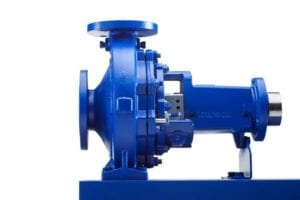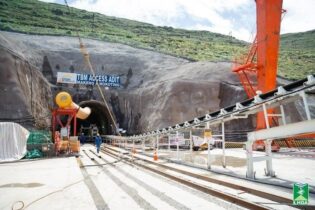New Etanorm series impresses with operating reliability, energy efficiency and versatility.
More power per pump – this is how one can summarise the principal characteristics of the new Etanorm type series. When optimising this classic pump, the development engineers made it a point to go the extra mile. It took numerous calculations, simulations and experiments until the experts were finally happy with the new Etanorm. The result is clear for all to see – the good old Etanorm new style will more than meet customer expectations. Role models tend to have a hard time; besides always giving their best performance, they also have to look for ways to improve further. The same is true of KSB’s Eta family pumps. The type series goes back to 1936, and upwards of 1.5 million units have been sold to date. This makes it the most successful standardised water pump of the world. The pump’s success is largely based on the wide variety of design variants and the broad range of applications resulting from these. The Eta product range comprises conventionally sealed water pumps in a wide variety of designs ranging from variable speed models to the zero-leakage Etaseco. To further increase customer benefit, all pumps can be automated, for example by combining them with PumpDrive and a Hyamaster (speed control) or PumpMeter. In other words, the Eta pump family has a solution to offer for almost every pumping problem. The challenge facing the team of development engineers headed by KSB’s Dr Norbert Kastrup, product development: Single-stage Pumps, started with what actually was quite a simple question – How do we inject a pump that has already been known for a long time for its low energy consumption, reliability and durability with fresh momentum? After much debate, there were two things that provided the impetus for a renewed technical overhaul and optimisation of the Etanorm. Setting standards around the world The first impetus was the result of the demands made by the international market. Many of our products’ users are global players who form part of an international network. They tend to favour standardised products, in particular where spare parts stocking is concerned. This was exactly the point that had posed a real challenge thus far. Irrespective of its design or features, the Etanorm has very successfully made a name for itself in almost every country in the world. However, over the years, KSB had had to come up with numerous design variations to meet the needs of particular countries, so that although the pumps were still similar at heart, the number of design differences had gradually increased. Not only did this mean that KSB had to cope with an enormous complexity of having to produce spare parts and accessories for every single pump series. The users themselves were also faced with having to stock multiple sets of spare parts, for example, if they ordered pumps both in Europe and in Asia. To do away with this problem, KSB decided to standardise the Etanorm and to set the same quality standards at all production facilities in the world. The second impetus was given by the so-called ErP Directive (EU Regulation 547/2012), also known as ecodesign directive. Although many pumps today already meet requirements that will not take effect until 2015, it was still KSB’s goal to become better still. KSB’s trend-setting FluidFuture campaign is the logical further development of this approach. FluidFuture is the name of a concept consisting of all products and services that together make for an energy-efficient way to run a system. The concept is holistic in nature, i.e. besides the pump itself, it also looks at the system as a whole through the eyes of a pump expert. High energy efficiency Let us now come back to the Etanorm once more: to meet the objectives of high efficiency and low energy consumption, the pump’s hydraulic system is key. Generally speaking, the old style Etanorm pumps were also able to convince, thanks to their optimised hydraulic systems. And the finely graduated selection charts allowed engineers to find exactly the right pump size for the intended application. But KSB decided to go a step further: “Our strength is that we precisely match the pump to the specific requirements such that, for example, the energy consumption is minimised and the operating costs are reduced,” Kastrup explains. In addition to the hydraulic system and the trimmed impeller, variable speed operation in connection with PumpDrive and a standard IE2 motor is equally instrumental in keeping energy costs, and hence the cost of operation, down. Combined with the innovative KSB SuPremE motor, efficiency level IE4 with at least 15% less power loss can be achieved already today. Reliability of operationPlant operators are also interested in the reliability of their systems. For one, KSB has added several pump sizes to the selection chart of the type series. And by increasing the rigidity, the pump casings can now absorb higher forces and moments imparted by the pipelines; this makes for a further increase in reliability. This wasn’t the only design change, however.The bearing bracket has been reinforced further to minimise the vibrations generated by the running pump. And even if operating conditions vary and the fluid pumped contains solids, the confined casing gasket and optimised casing cover ensure that operation is reliable. Moreover, the pump boasts excellent suction performance and virtually cavitation-free operation across a wider operating range. This results in a low wear rate and exceptionally smooth operation.
Highly versatile – for every type of application A total of 43 sizes is now available. “From the point of view of their hydraulic systems, several sizes remained the same, but 23 sizes offered scope for improvement,” Kastrup says. We used the finite element method (FEM) and computational fluid dynamics (CFD) for this. After optimising all hydraulic contours by means of CFD, the improvements were validated by testing them in extensive test set-ups. “Work on the hydraulic systems also resulted in several additional sizes for smaller flow rates, so that it is now easier to match the best efficiency point when selecting a pump,” Kastrup adds. Another innovation: “In the past, the sizes with a nominal impeller diameter of 315 were not suitable for 2-pole operation, because that put too much of a strain on the pumps,”he continues. This design variant is now also available. Kastrup’s team also studied the details of the various operating conditions. “Etanorm is a classic clean water pump that normally is not used in an abrasive environment. However, operators increasingly have to contend with solids, such as sand. We have taken this fact into account by making the shaft seal chamber more compatible with solids.” And there is a wide variety of materials to match the pump to the fluid to be handled. To cater to Asian markets, we have added bronze to our materials range for example, because it is the material of choice in India. Fast service What we expect users to value most, however, is that the Etanorm is now manufactured at all production facilities around the world according to the same quality standards. Aside from EN flanges, the pumps are also available with ASME flanges. The user gets a pump that is manufactured at all three production sites (Frankenthal, India and South Africa) according to the same quality and development specifications. This makes global procurement considerably easier, and increases the availability of pumps and spare parts. For example, the Etanorm can be easily installed in pipelines requiring an EN-type or ANSI-type flange. And although quality standards are the same everywhere, it is as important as ever that each pump is individually tailored to match local conditions. Pumps and accessories have to be capable of being adjusted to regional requirements quickly, easily and reliably. Thanks to KSB’s close-knit global sales and service networks, spare parts quickly reach their point of use. Servicing and maintenance of the new Etanorm are now also easier. Among others, this is due to the enlarged seal chamber, which makes for better venting, and the bolted connection between casing cover and bearing bracket, which is a feature of all pump sizes. “Admittedly, this does not sound very spectacular at first, but it is details like these that make maintenance much easier in practice,” Kastrup points out. As a further improvement, the interface between casing cover and bearing bracket now features forcing screws. The reason for this is that on grey cast iron pumps, in particular, the connection between the two parts often was very difficult to loosen after a long period of operation. On the new design, the cover is easy to open, even after many years. Outlook The term “standardised” in standardised water pump is somewhat misleading. After all, the Etanorm is one of the pumps with the greatest wealth of variants. “No more than 1.4% of the pumps of this series sold in 2011 were identical in design,” indicates Kastrup by way of example. The wide range of sizes and materials guarantees that users get pumps that are ideally suited for their particular conditions of use. A pump with an impeller carefully trimmed to match the operating point also warrants low-wear operation. In addition, the user benefits from the fact that the machines will be manufactured according to the same production and quality standards across the world from the spring of 2013. The design optimisations resulting from this development process provide important impulses and make sure the Etanorm retains its rolemodel status.







